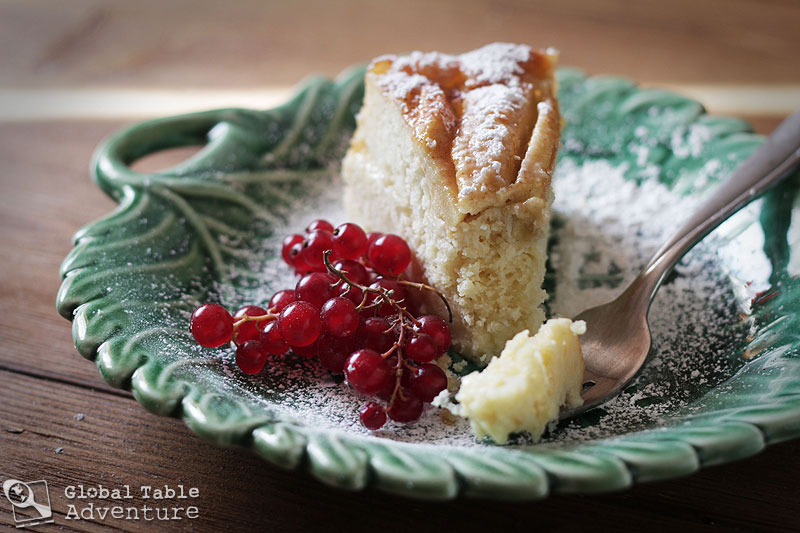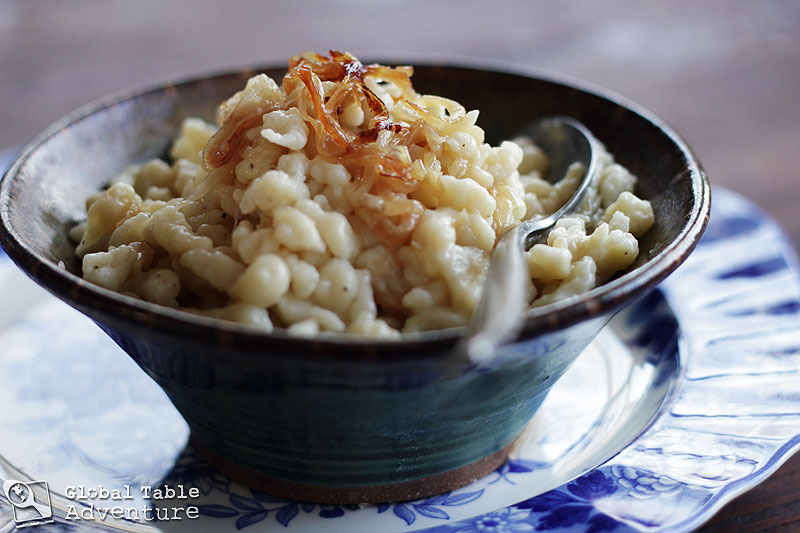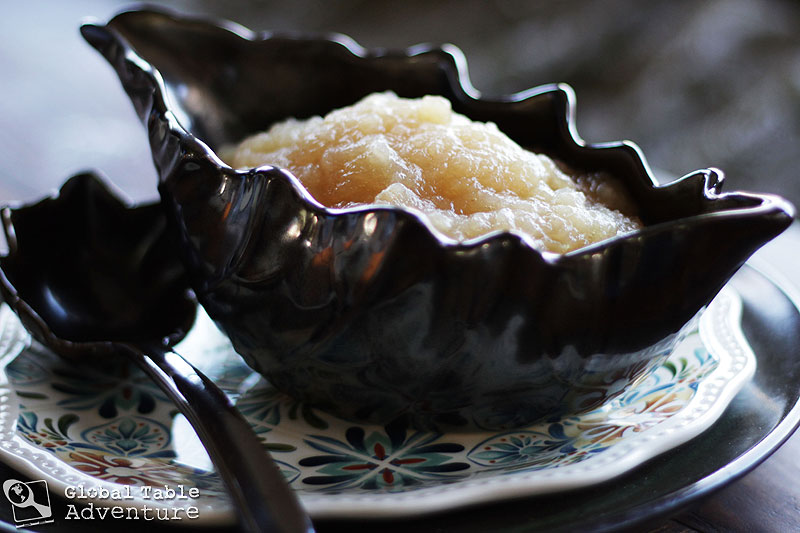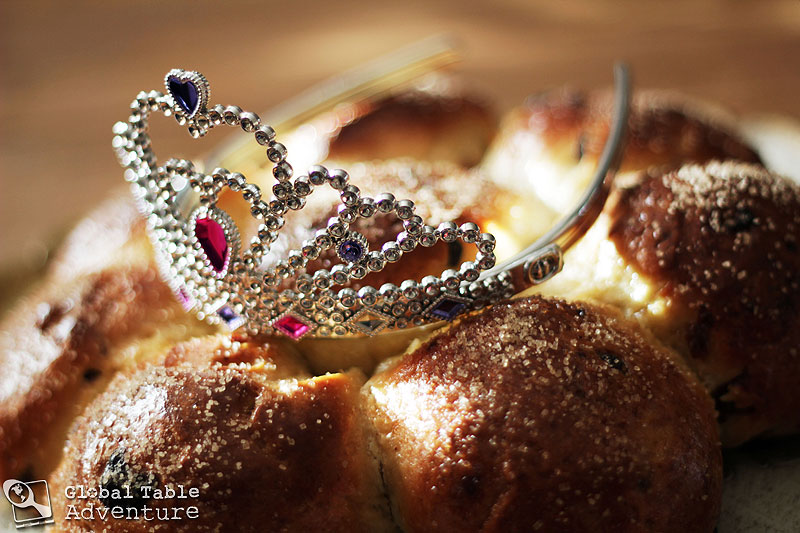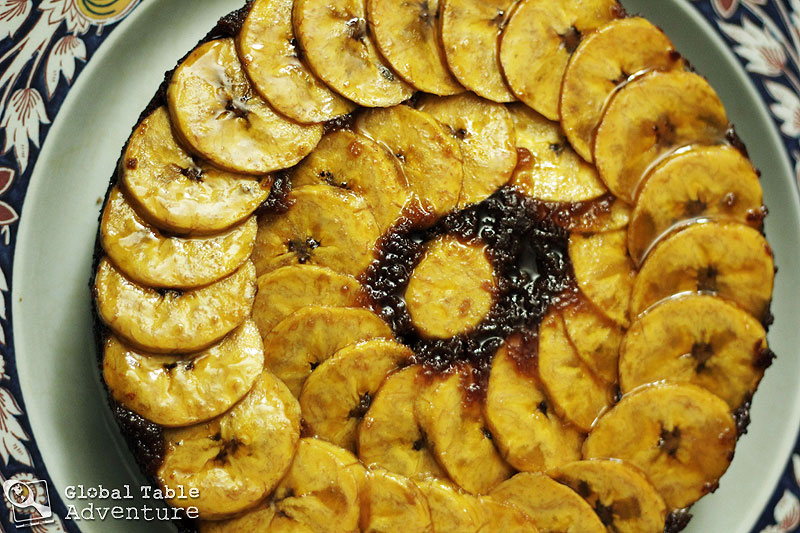In the southern reaches of Luxembourg, in an area called Gutland, live a happy collection of orchards where apples, plums, cherries and berries ripen in the sun. Now… I knew, without a doubt, that I absolutely, positively wanted to make a plum cake when we got to Luxembourg, however the seasons were against me. Since it is January and not a plum in sight, I somewhat grumpily resigned myself to making a traditional apple cake, a.k.a. Plan B. One bite in and I knew this was a fantastic choice. Made with a buttery dough and a wet custard, the two layers literally combine in the oven, creating a moist, incredibly delicious cake. When topped with a heavy dusting of cinnamon and confectioner’s sugar, all feels right with the world. Right… and very apple-tastic. NOTES: Use a 8″ cake pan with standard 2″ inch sides (no shorter). Do not use a springform pan, as the milk mixture will certainly leak out. The easiest way to remove the cake from cake pan is to let cool until …
Read More
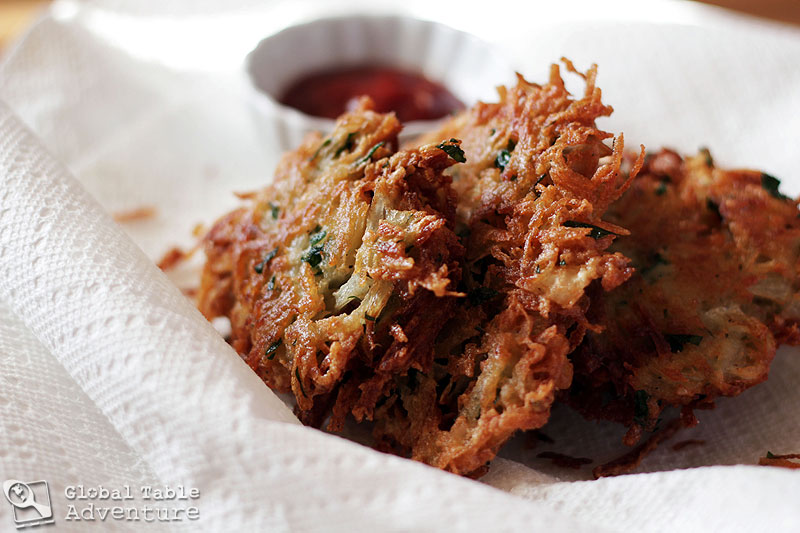
My first taste of Luxembourg’s Gromperekichelcher was during the annual Christmas market. The town square buzzed with happy shoppers and carolers whose voices floated down from the bandstand. The smell of fried potatoes and onions was just about enough to send anyone straight for their wallet so, of course, I happily complied. While most Luxembergers dunked their fritters in apple sauce, I went straight for the ketchup. It was an easy thing to do and it made my new home a little more familiar – a little more like the United States, which I had left back in 1992. The irony is, of course, that now I eat the fritters with ketchup because it reminds me of Luxembourg. It’s amazing how memories travel with our taste buds, wherever we go. Even though I left Luxembourg after high school, in 1998, I simply have to smell fried potatoes to go back there. In those moments, I remember the friends and the food. The troubles and the laughter. The tears and the songs. It all comes bundled up together, …
Read More
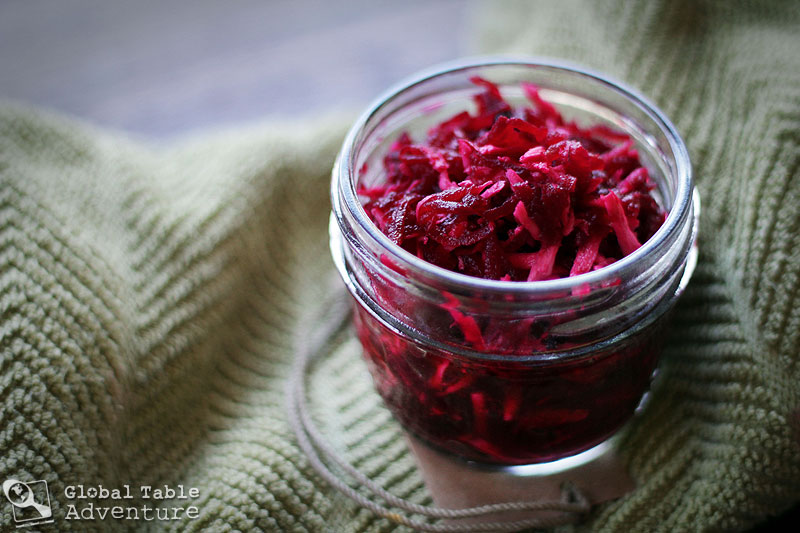
It may have happened when you were five. Or maybe, just maybe, not until today. Either way, this much I know for sure: there comes a time in every person’s life when they come face to face with the mighty beet. Some will cower or run away, while others – like the Lithuanians, will chow down with enthusiasm. In this traditional slaw, roasted beets blend with tear-inducing horseradish and vinegar…creating a spicy, sour accompaniment that goes particularly well with beef and fish. P.S. Start this recipe a day or two before you need it, to give the ingredients time to mingle. Ingredients: 3/4 lb beet(s) (or 1- 1 1/2 cup(s) roasted, grated beets) 1 cup grated horseradish (about 1 whole horseradish, peeled & grated) 1/2 cup white wine vinegar 1/2 cup water 10 peppercorns, cracked or coarse ground pepper sugar, to taste salt Method: While this recipe will work with any old red beet, it’s always better to find the most GIANT beet in the world. Look how this one dwarfts my loaf pan… it’s …
Read More
Once, when I was in my first decade of life, I stared at a platter of chilled, “eyeball eggs,” as I called them, and vowed to never, ever eat one. A temper tantrum may, or may not have been involved. Now, two decades later, here I am, on the other side of the fence, albeit somewhat mystified how it came to be that I now scan buffets for the little suckers. I think the name says it all; like the neighborhood bad boy, the deviled egg is a love-it or hate-it treat. And, as with wine and coffee, appreciation almost always comes later in life. Unless… you live in Lithuania. There, eggs are as adored as apples, and more so on a cold buffet with additives like fish or mushrooms – the stinkier the better. For this week’s Global Table, I made a Lithuanian-inspired Deviled Egg, complete with fried mushrooms, dill, and sour cream. Why mushrooms? As one Lithuanian reader noted, “Mushroom foraging is like a sport in Lithuania (especially in the South) and I …
Read More
When I told Keith, a.k.a. Mr Picky, what was for dinner this week, he said “Bless you.” You try saying it – Käsknöpfle – and see if you get the same response. Some words just sound like a sneeze, I guess. But don’t let that fool you. This week’s Käsknöpfle is … ahem… nothing to sneeze at. This wonderful, cheesy pasta dish enjoyed in Liechtenstein is like mac and cheese, but all grown up … a meal that has had a few years to explore the world and came back refreshed and refreshing – a great, big bowl of alpine comfort… A free spirit, if you will. This recipe is for the days when you don’t want everything all wrapped up in a neat little bow. When you want things to be squiggly. And cheesy. And oniony. Trust me, it’s not too much to ask for. Just ask Liechtenstein. The fine folks of Liechtenstein recommend three cheeses… Fontina is creamy and has a bit of tang, Gruyere is salty and a bit drier (a bit reminiscent of Parmesan), and Emmenthalier is like a mild …
Read More
Sometimes I buy fruit and it just… sits there. Life takes over. I go for hikes, I play catch with my daughter, I eat the candy from my stocking, and… before I know it, I just forget to eat them. I do this a lot with apples because they last so long and are so forgiving. Eventually, the time comes when they lose a bit of shine and a few bruises pop up. If this should happen to you, applesauce is the way to go. I didn’t realize how easy it would be to make until I did it this week. Trust me, you can do this. In countries like Liechtenstein applesauce is the go-to side dish for all sorts of meals, like Schnitzel [recipe] and Käsknöpfle (recipe will be up this weekend). The fresh flavor will totally make you forget that you left your apples just …. sitting there… for so … long. Best part? No fancy equipment required. Just a plain ol’ wooden spoon. That’s love right there. Here’s the easy, peasy recipe: Makes 2 …
Read More
Epiphany. People use the word to say they had a great idea. Like the proverbial lightbulb going off over one’s head. But we’re not going to eat lighbulbs today. Nope. Epiphany is the time of year that Liechtenstein, as well as many other countries around the world, celebrate “little Christmas.” This national holiday is celebrated on January 6 and is a nod to the late arrival of the 3 kings to the very first Christmas party… afterall, they did hike quite a ways to get to Bethlehem. Calling the Dreikönigskuchen a cake is somewhat a misnomer as it is really more of a sweet roll. You can find it fresh in bakeries all over Liechtenstein. Filled with fresh citrus rind, sweet raisins and bound with the richness of milk and butter, it’s a fantastic treat on a cold winter’s day. The best part? A single almond is hidden inside one of the rolls. Whoever finds it gets to be King (or Queen) for the day. It’s a beautiful and fun game for kids. Once the winner is …
Read More
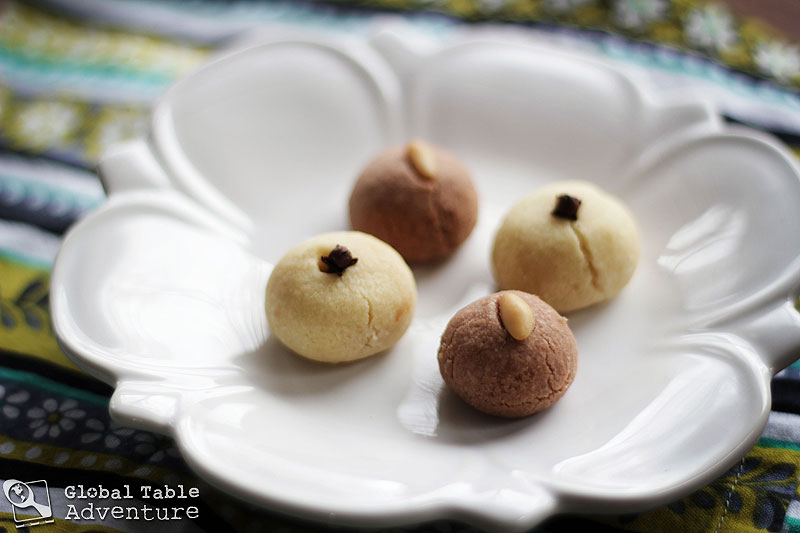
Every day should be special. A day to use fancy napkins. A day to nibble cookies with tea. A day to smile more than you did the entire year before. This cookie is for such a day. Say hello to the ghraiba, or Libya’s answer to crispy, buttery shortbread. They aren’t super sweet, but they have a tender crumb, perfect for teatime. Two things make these cookies unique. First, they are made with ghee, a.k.a. cooked, clarified butter. Second, they are studded with whole cloves, which can be eaten in their entirety. The quick bake in the oven mellows the flavor enough to make the experience bearable. I made half of the cookies plain and half of them with a hit of cocoa. Decorated with whole cloves (yes, eat the whole thing!) and pine nuts, they make for a delightful giftbox for a hostess gift. The funny thing about these cookies is that they do not spread. At all. And they cook very quickly, so plan accordingly Makes several dozen 1 inch balls. Ingredients: 7.5 ounces ghee, room temperature (about a …
Read More

Welcome to my weakness. The mango. If you’ve been paying attention, you may have noticed I make a lot of recipes with this heavenly fruit. Quite possibly I’ve made more mango recipes than anything else. Everything about the mango is perfect. Sweet. Golden. Juicy. And, right now, totally in season. So, go find one (or five hundred). Rain or shine. In Liberia they like to chop them up and cook them with cloves. About four cloves will give the mango an alluring, but not overpowering flavor – reminiscent of pie filling. If the mangoes are perfectly ripe, they don’t even need sugar. Otherwise, a spoonful should do you. Cook for just ten minutes and serve this as-good-as-pie-filling with a big dollop of whipped cream. The whipped cream melts just a little from the heat of the snuggly-warm mangoes… Good luck sharing this with anyone else. I ate the whole thing by myself. Ava was napping. Keith was working. And I, … well, I have no regrets. Here’s how you do it: Serves 1-2 Ingredients: 2 cups …
Read More
I find that Mr. Not-as-Picky, Keith – even with all his progress on the adventure – can still be rather fussy about food that looks soft and mushy. Especially if he has to eat it with his fingers. If you ask me, some of the best food is soft and mushy – mashed potatoes being the prime example. So I’ll you what I told him. Papa, a stiff white porridge from Lesotho, is not that unusual. Especially if you eat grits for a living, which – apparently – many people do, here in the south. The best way to approximate Papa is by simply taking grits – the white ones – and make them a bit thicker than usual. When you’re done whisking, whisking, whisking, you’ll have a beautiful, scoopable papa – not unlike polenta in texture. It looks soft and mushy, but in fact, this papa is rather solid once cooled. Serves 2-4 Ingredients: 1/2 cup white grits 1 1/4-1 1/2 cups stock (your preference) salt Method: Bring stock to boil. Stream in grits, …
Read More
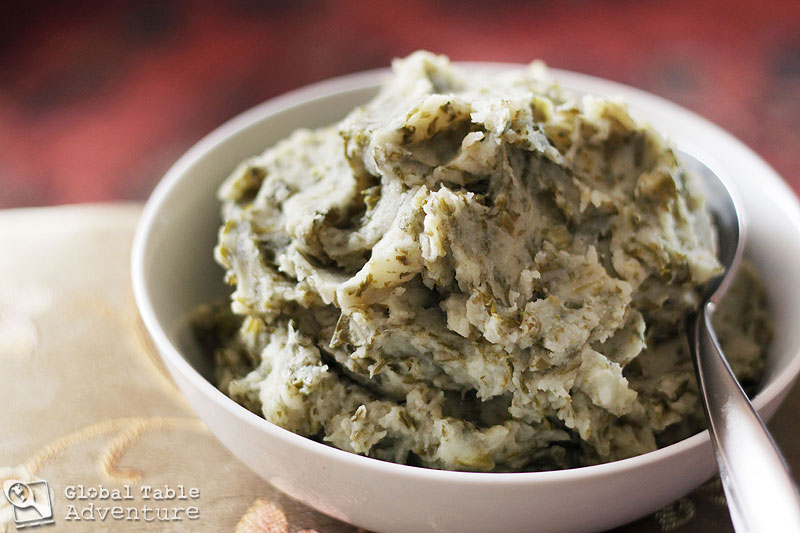
Today I’m partnering with your mother. It’s cold outside. Let’s all bundle up in our favorite fuzzy-wild-animal-looking hoodies. Let’s wear face masks and giant mittens. And let’s definitely eat our vegetables. Lots and lots of veggies. Today’s recipe is inspired by moroko, a dish enjoyed in the African country, Lesotho. Typically, Moroko is made with onions and greens, sauteed in oil with a bit of broth, not unlike the Kale (Sukuma Wiki) we made recently for Kenya. Moroko can be made with any dark greens you’d like, such as kale, spinach, chard, or mustard greens. Optionally, beans or potatoes can be added. But I have a secret – the most wonderful mash around is when you add mustard greens to potatoes. And this mash, inspired by Lesotho, is what we’re serving up today. Turns out this is the mashed potatoes your mother always dreamed you would eat. Loaded with nutrients. And really, really green. Serves 2-4 Ingredients: 1 bunch mustard greens, chopped finely 3 fairly large russet potatoes, peeled and roughly cubed stock, as needed – I used …
Read More

